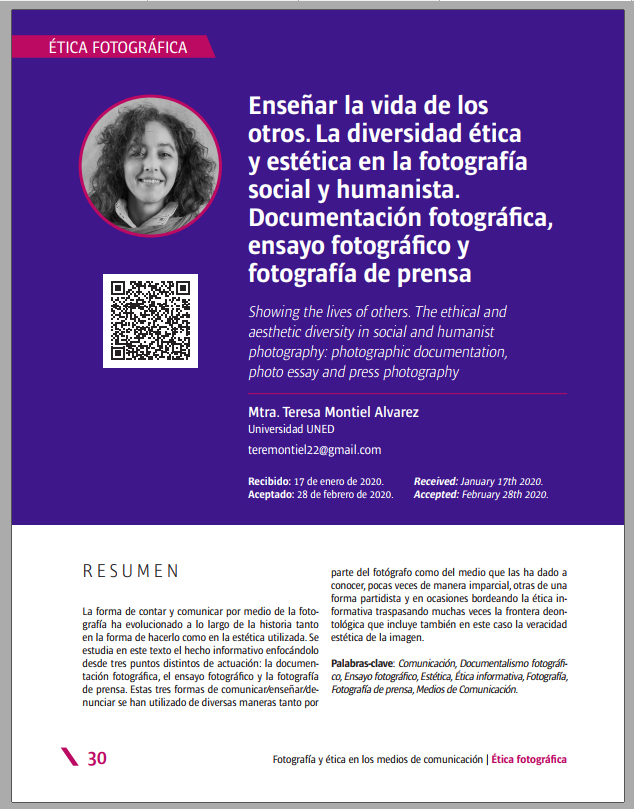Enseñar la vida de los otros. La diversidad ética y estética en la fotografía social y humanista. Documentación fotográfica, ensayo fotográfico y fotografía de prensa.
Contenido principal del artículo
Resumen
La forma de contar y comunicar por medio de la fotografía ha evolucionado a lo largo de la historia tanto en la forma de hacerlo como en la estética utilizada. Se estudia en este texto el hecho informativo enfocándolo desde tres puntos distintos de actuación: la documentación fotográfica, el ensayo fotográfico y la fotografía de prensa. Estas tres formas de comunicar/enseñar/denunciar se han utilizado de diversas maneras tanto por parte del fotógrafo como del medio que las ha dado a conocer, pocas veces de manera imparcial, otras de una forma partidista y en ocasiones bordeando la ética informativa traspasando muchas veces la frontera deontológica que incluye también en este caso la veracidad estética de la imagen.
Detalles del artículo
Sección

Esta obra está bajo una licencia internacional Creative Commons Atribución-NoComercial-SinDerivadas 4.0.
Cómo citar
Referencias
Doud, R. (1964): “Oral history interview with Arthur Rothstein, 1964 May 25”, Archives of American Art, 25 de mayo, https://www.aaa.si.edu/collections/interviews/oral-history-interview-arthur-rothstein-13317#transcript (Último acceso 7 de enero de 2020)
Espada, A. (2004): “La necesidad de la imagen: Entrevista a Susan Sontag”, Letras Libres, 30 de abril http://www.letraslibres.com/revista/convivio/la-necesidad-de-la-imagen-entrevista-con-susan-sontag (Último acceso 3 de enero de 2020)
Estrin, J. (2014): “Truth and consequences for a war photographer”, Lens, photography, video and visual journalism. The New York Time, 24 de enero https://lens.blogs.nytimes.com/2014/01/24/truth-and-consequences-for-a-war-photographer/ (Último acceso 10 de enero de 2020)
Fowler, J. (2012): “By the way”, National Review, 19 de septiembre, https://www.nationalreview.com/corner/way-jack-fowler-2/# (Último acceso 10 de enero de 2020)
Greenslade, R. (2010): “Exposed – The Economist’s image of a lonely president who was not alone” The Guardian, 6 de julio
https://www.theguardian.com/media/greenslade/2010/jul/06/the-economist-news-photography (Último acceso 10 de enero de 2020)
Halsmann, P. (1956 aprox.): W. Eugene Smith: ‘I Didn’t Write the Rules, Why Should I Follow Them?’, Lens, photography, video and visual journalism. The New York Time. 3 de enero de 2013.
Krase, A. (2001). Paris Eugène Atget. Germany. Taschen
Mraz, J. (2003): “¿Qué tiene de documental la fotografía? Del fotorreportaje dirigido al fotoperiodismo digital”, Zonezero. Enero 2013 http://v1.zonezero.com/magazine/articles/mraz/mraz03sp.html (Ultimo acceso 9 de enero de 2020)
McDonald, M. (2005) “When People’s Suffering is Portrayed as Art”. Niemanreports, 15 de marzo http://niemanreports.org/articles/when-peoples-suffering-is-portrayed-as-art/ (Último acceso 13 de enero de 2020)
Platoff, A. (2013). “Of Tablecloths and Soviet Relics: A Study of the Banner of Victory (Znamia Pobedy). Raven: A Journal of Vexillology, v. 20. 55-83. https://escholarship.org/uc/item/2db980gg (Último acceso 9 de enero de 2020)
Romero Escribá, R. (2013). Las dos mitades de Jacob Riis. Un estudio comparativo de su obra literaria y fotográfica. Vol. 1 Cuadernos de Bellas Artes 28.
The New York Times. (2013, enero 3). W. Eugene Smith: «I Didn’t Write the Rules, Why Should I Follow Them?» Lens Blog. https://lens.blogs.nytimes.com/2013/01/03/w-eugene-smith-i-didnt-write-the-rules-why-should-i-follow-them/
Sánchez, F. , Fernando (2016): “Eugene Smith en deleitosa, ¿la misma cara de la moneda?”, FERFOTOblog, 9 de junio http://www.ferfoto.es/ferfotoblog/fotograficamente-hablando/eugene-smith-steve-mccurry-la-misma-cara-la-moneda/ (Último acceso 3 de enero de 2020)
Seelye, K., Bosman, J. (2006): “Bloggers Drive Inquiry on How Altered Images Saw Print”, The New York Times 9 de agosto. (ultimo acceso 7 de enero de 2020)
Van Ripper, F. (2003): “Manipulating Truth, Losing Credibility”. Camera Works para The Washington Post (s/f) https://www.washingtonpost.com/wp-srv/photo/essays/vanRiper/030409.htm? (Último acceso 11 de enero de 2020)

